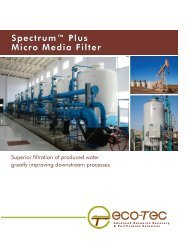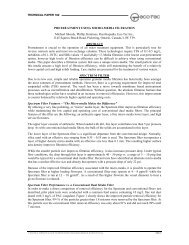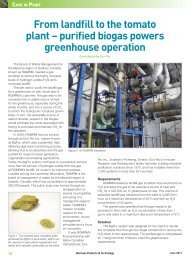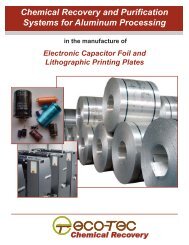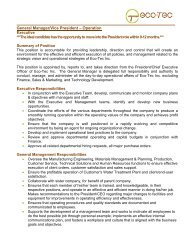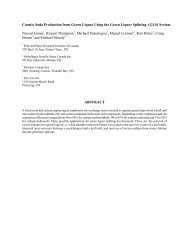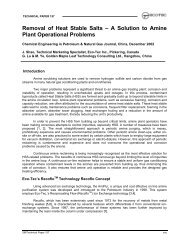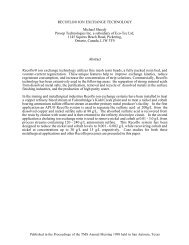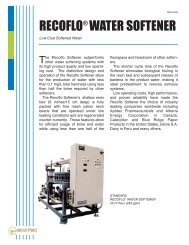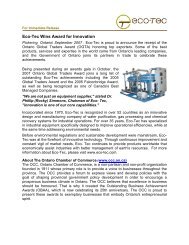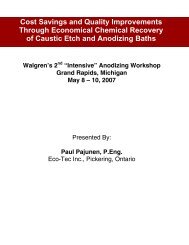Mixed acid recovery with the apu acid sorption - Eco-Tec
Mixed acid recovery with the apu acid sorption - Eco-Tec
Mixed acid recovery with the apu acid sorption - Eco-Tec
Create successful ePaper yourself
Turn your PDF publications into a flip-book with our unique Google optimized e-Paper software.
TECHNICAL PAPER 147<br />
MIXED ACID RECOVERY <strong>with</strong> <strong>the</strong> APU <br />
ACID SORPTION SYSTEM<br />
CRAIG BROWN, Prosep <strong>Tec</strong>hnologies , <strong>Eco</strong>-<strong>Tec</strong> Inc., Pickering, Ontario<br />
An Update<br />
SUMMARY<br />
Since <strong>the</strong> first APU <strong>acid</strong> <strong>sorption</strong> system was installed in 1982 for <strong>recovery</strong> of mixed nitric/hydrofluoric<br />
<strong>acid</strong> stainless steel pickle liquors, <strong>the</strong> industry has embraced <strong>the</strong> technology, so that by now most mills<br />
have installed systems of this type. Although <strong>the</strong> basic technology has been available for more than<br />
twenty years, <strong>the</strong> APU system has been enhanced through improved flow distribution, filtration, analytical<br />
tools and process controls.. Safety concerns about treatment of nitric <strong>acid</strong> have been addressed by<br />
cooling <strong>the</strong> pickle prior to treatment. This paper will review <strong>the</strong>se developments and discuss some new<br />
innovations that are coming in <strong>the</strong> future.<br />
Keywords: nitric <strong>acid</strong>, hydrofluoric <strong>acid</strong>, ion exchange, stainless steel, pickle, <strong>recovery</strong><br />
1. INTRODUCTION<br />
In 1963 a new process for separation of strong <strong>acid</strong>s from metal salts was introduced by Hatch [i]. Called<br />
'<strong>acid</strong> retardation', <strong>the</strong> process held considerable promise for purification of waste <strong>acid</strong>s generated in<br />
pickling metals and leaching ores. The primary appeal of <strong>the</strong> <strong>acid</strong> retardation process is that <strong>the</strong> <strong>acid</strong> that<br />
is sorbed by <strong>the</strong> ion exchange resin can be recovered by a simple water elution. Consequently,<br />
economical <strong>recovery</strong> of a chemical as cheap as sulfuric <strong>acid</strong> can be contemplated. Although a few early<br />
attempts were made to commercially exploit <strong>the</strong> process, it was not until 1977 when <strong>Eco</strong>-<strong>Tec</strong> introduced a<br />
system called <strong>the</strong> APU® (<strong>acid</strong> purification unit) for purification of sulfuric <strong>acid</strong> anodizing solutions [ii] that<br />
<strong>the</strong> process became commercially viable. This process very quickly became accepted by <strong>the</strong> aluminum<br />
finishing industry around <strong>the</strong> world, <strong>with</strong> hundreds of units being installed.<br />
Over <strong>the</strong> ensuing years a large number of APU’s were installed on a wide variety of applications, including<br />
steel pickling baths. Although <strong>the</strong>se included sulfuric and hydrochloric <strong>acid</strong> carbon steel pickling baths, it<br />
quickly became evident that <strong>the</strong> economics of recovering hydrochloric and sulfuric <strong>acid</strong> pickle liquors<br />
were marginal. A much more attractive application was purification of stainless steel pickle liquors based<br />
upon mixed nitric/ hydrofluoric <strong>acid</strong>. In 1982 <strong>the</strong> first APU was installed on a stainless steel pickling<br />
application. Since that time over seventy units have been installed in fifteen different countries. In<br />
addition to <strong>the</strong> cost savings, a number of productivity improvements have been identified when an APU<br />
system is operated [iii].<br />
2. BASIC APU PROCESS DESCRIPTION<br />
One of <strong>the</strong> reasons that it took so long for <strong>the</strong> <strong>acid</strong> retardation process to become commercialized is that<br />
conventional ion exchange designs, originally developed for treatment of large volumes of water, are not<br />
well suited to <strong>the</strong> treatment and production of small volumes of concentrated liquors. A key to <strong>the</strong><br />
success of <strong>the</strong> <strong>acid</strong> retardation process has been utilization of a novel ion exchange process called<br />
Recoflo, which was originally developed at <strong>the</strong> University of Toronto. The original Recoflo process is<br />
characterized by <strong>the</strong> use of short beds of fine mesh ion exchange resins, operated in a counter-current<br />
flow scheme.<br />
SM/<strong>Tec</strong>hnical Paper 147 01/97
TECHNICAL PAPER 147<br />
There are two steps in <strong>the</strong> basic Recoflo APU process - <strong>the</strong> "upstroke" and <strong>the</strong> "downstroke" (see Figure<br />
1). During <strong>the</strong> upstroke, spent <strong>acid</strong> is pumped into <strong>the</strong> bottom of <strong>the</strong> resin bed. Acid is sorbed by <strong>the</strong><br />
resin particles and <strong>the</strong> remaining de-<strong>acid</strong>ified metallic salt solution, designated arbitrarily as <strong>the</strong><br />
"byproduct" is collected from <strong>the</strong> top of <strong>the</strong> bed. Next, during <strong>the</strong> downstroke, water is pumped into <strong>the</strong><br />
top of <strong>the</strong> bed, desorbing <strong>the</strong> purified <strong>acid</strong> from <strong>the</strong> resin so that a purified <strong>acid</strong> "product" is collected from<br />
<strong>the</strong> bottom of <strong>the</strong> bed. Control is achieved by measurement of stroke volumes. The total cycle typically<br />
takes about 5 minutes to complete and repeats successively.<br />
water<br />
salt<br />
byproduct<br />
1. Upstroke<br />
spent<br />
<strong>acid</strong> water<br />
Figure 1: APU Operating Cycle<br />
3. IMPROVED FLOW DISTRIBUTION<br />
<strong>acid</strong><br />
product<br />
2. Downstroke<br />
spent<br />
<strong>acid</strong><br />
Since in <strong>the</strong> <strong>acid</strong> retardation process only a relatively small volume of <strong>acid</strong> can be treated during each<br />
<strong>sorption</strong> cycle, <strong>the</strong> challenge lies first of all, in minimizing <strong>the</strong> amount of water employed for <strong>the</strong> elution<br />
step, to avoid diluting <strong>the</strong> recovered <strong>acid</strong>. Secondly, to maximize <strong>the</strong> purity of <strong>the</strong> recovered <strong>acid</strong>, it is<br />
important to minimize mixing of <strong>the</strong> contaminated feed <strong>acid</strong> <strong>with</strong> <strong>the</strong> purified recovered <strong>acid</strong>. The original<br />
Recoflo process went a long way to addressing <strong>the</strong>se issues by using a fully packed bed resin bed and<br />
essentially eliminating <strong>the</strong> freeboard above <strong>the</strong> resin that is found in conventional ion exchange columns.<br />
In <strong>the</strong> mid 1980’s it was found that <strong>the</strong> efficiency of <strong>the</strong> Recoflo process could be fur<strong>the</strong>r enhanced by<br />
improving <strong>the</strong> uniformity of flow distribution of fluid passing through <strong>the</strong> bed. This was accomplished by<br />
packing <strong>the</strong> resin bed in such a way such that <strong>the</strong> resin is always maintained in a state of compression,<br />
even when <strong>the</strong> resin has shrunk. This patented [iv] technique is called ‘over-packing’.<br />
It is well known that ion exchange resins change volume as <strong>the</strong>y are converted from one ionic form to<br />
ano<strong>the</strong>r and when <strong>the</strong> concentration of <strong>the</strong> surrounding solution is changed. For example, resins<br />
normally shrink in concentrated solutions such as <strong>acid</strong>s and <strong>the</strong>y swell again when placed in water. This<br />
volume change, which is reversible, can be as much as 10% and has a significant effect on flow<br />
distribution.<br />
Figure 2 represents a bed of resin in which <strong>the</strong> resin just fills <strong>the</strong> vessel at <strong>the</strong> start of <strong>the</strong> upstroke or <strong>acid</strong><br />
<strong>sorption</strong> step, ie. just after <strong>the</strong> downstroke or water elution step has been completed. In this case, <strong>the</strong><br />
resin bed fully occupies <strong>the</strong> space in <strong>the</strong> vessel and could be considered 'packed' but not yet 'overpacked'.<br />
In o<strong>the</strong>r words <strong>the</strong> resin is not under compression by any force o<strong>the</strong>r than that of gravity. The<br />
bed at this point is relatively uniformly packed however, <strong>with</strong> each resin bead in contact <strong>with</strong> <strong>the</strong> adjacent<br />
beads.<br />
SM/<strong>Tec</strong>hnical Paper 147 01/97
TECHNICAL PAPER 147<br />
No flow distribution system is perfect, so that when <strong>the</strong> <strong>acid</strong> enters <strong>the</strong> bottom of <strong>the</strong> bed, <strong>acid</strong> will initially<br />
touch some portion of <strong>the</strong> resin bed slightly before ano<strong>the</strong>r location. As discussed above, <strong>the</strong> resin at this<br />
point of initial contact will shrink when it is contacted by <strong>the</strong> <strong>acid</strong>. This will increase <strong>the</strong> space between <strong>the</strong><br />
resin beads at this point (ie. increase <strong>the</strong> local bed porosity) and <strong>the</strong>refore reduce <strong>the</strong> liquid pressure drop<br />
at this point. The reduced pressure drop will accelerate <strong>the</strong> flow of <strong>the</strong> <strong>acid</strong> through <strong>the</strong> bed at this point,<br />
<strong>the</strong>reby causing a flow channel to develop. As more <strong>acid</strong> is pumped into <strong>the</strong> resin bed, <strong>the</strong> flow channel<br />
becomes more pronounced and propagates through <strong>the</strong> bed. The net result of this is that <strong>the</strong> flow<br />
distribution is adversely affected to a significant extent. In practical terms, this results in a slightly higher<br />
concentration of free <strong>acid</strong> in <strong>the</strong> de-<strong>acid</strong>ified metal salt byproduct or waste produced by <strong>the</strong> unit and a<br />
slightly higher concentration of metal in <strong>the</strong> purified <strong>acid</strong> product.<br />
Under over-packed conditions, when <strong>the</strong> <strong>acid</strong> initially contacts <strong>the</strong> resin and causes a portion of <strong>the</strong> resin<br />
to shrink as discussed above, some of <strong>the</strong> compressed resin from <strong>the</strong> surrounding region flows into <strong>the</strong><br />
space developed, relieving a portion of <strong>the</strong> resin compression (see Figure 3). As a result, <strong>the</strong>re is no<br />
localized increase in <strong>the</strong> bed porosity and no flow channels develop.<br />
Typical performance results for a recent APU installation are shown in Table 1. It can be seen that 98% of<br />
<strong>the</strong> free hydrofluoric <strong>acid</strong> and virtually all of <strong>the</strong> free nitric <strong>acid</strong> values have been recovered. Seventy<br />
percent of <strong>the</strong> metals have been removed from <strong>the</strong> purified <strong>acid</strong> product. It should be noted that it is<br />
possible to fur<strong>the</strong>r improve <strong>the</strong> metal removal efficiency by adjustment of <strong>the</strong> unit operating conditions,<br />
although <strong>the</strong>re is really no benefit in doing so.<br />
increased<br />
localized<br />
porosity<br />
FLOW<br />
shrunken<br />
resin<br />
Figure 2: Flow Channeling in a Packed Bed<br />
SM/<strong>Tec</strong>hnical Paper 147 01/97
TECHNICAL PAPER 147<br />
FLOW<br />
overpacked<br />
resin fills<br />
spaces<br />
Figure 3: Improved Flow Distribution in an Over-Packed Bed.<br />
Table 1: Recent APU Field Results With An Over-Packed Bed<br />
Volume<br />
Free HNO3 Free HF<br />
Total metals<br />
(L/Lfeed) (g/L)<br />
(g/L)<br />
(g/L)<br />
Feed 1 107 19.3 45<br />
Product 1.01 104 18.5 12.6<br />
Byproduct 1.0 0 0.3 30.4<br />
Mass balance -1.9% -1.7% -3.9%<br />
4. CHEMICAL ANALYSIS<br />
overpacked<br />
resin<br />
In order to properly evaluate <strong>the</strong> performance of an APU system it is necessary to have a way to accurately<br />
analyze <strong>the</strong> chemical composition of all <strong>the</strong> streams entering and leaving <strong>the</strong> unit. A significant<br />
advancement in <strong>the</strong> analysis of stainless steel pickle liquors was <strong>the</strong> development by Lindroos [v] of a ion<br />
selective electrode (ISE) technique for free hydrofluoric <strong>acid</strong>. Unlike conventional ISE methods, <strong>the</strong><br />
Lindroos technique does not require dilution of <strong>the</strong> sample. Moreover, unlike <strong>the</strong> conventional<br />
procedure, <strong>the</strong> Lindroos technique provides a measure of free hydrofluoric <strong>acid</strong> ra<strong>the</strong>r than total fluoride.<br />
This technique does suffer from a number of disadvantages however, including:<br />
1. The HF electrode has a limited lifetime.<br />
2. The output from <strong>the</strong> electrode is very sensitive to temperature variations resulting in a significant<br />
potential source of error.<br />
3. The HF electrode requires frequent re-calibration.<br />
Two commercial systems that utilize this novel ISE technique have been introduced for analysis of mixed<br />
<strong>acid</strong> stainless steel pickle liquors. The Scanacon SA system takes a density measurement and an<br />
SM/<strong>Tec</strong>hnical Paper 147 01/97
TECHNICAL PAPER 147<br />
expanded scale pH measurement along <strong>with</strong> <strong>the</strong> ISE measurement. Concentrations of nitric <strong>acid</strong> and total<br />
metals are <strong>the</strong>n empirically calculated. While this technique is quite simple and quick, it suffers from a<br />
couple of disadvantages: First of all, <strong>the</strong> life of <strong>the</strong> proprietary pH electrode, which is ra<strong>the</strong>r expensive, is<br />
limited. Secondly, <strong>the</strong> accuracy is not particularly good, especially for APU byproducts, where <strong>the</strong><br />
concentration of free <strong>acid</strong> is very low and <strong>the</strong> metals concentration is very high.<br />
<strong>Eco</strong>-<strong>Tec</strong> offers ano<strong>the</strong>r analytical technique which utilizes <strong>the</strong> ISE HF measurement. In <strong>the</strong> <strong>Eco</strong>-<strong>Tec</strong><br />
ADI1000 and ADI 2000 systems, <strong>the</strong> ISE measurement is complemented by a proprietary automated<br />
titration. The titration procedure provides total free <strong>acid</strong> and total metal concentrations. The free nitric <strong>acid</strong><br />
is calculated by subtracting <strong>the</strong> free HF number (from <strong>the</strong> ISE) from <strong>the</strong> total free <strong>acid</strong> number. The major<br />
advantage of <strong>the</strong> ADI system is its high accuracy. The excellent mass balance shown in Table 1 is an<br />
indication of <strong>the</strong> accuracy of <strong>the</strong> ADI system. Although it takes 10-20 minutes to complete one analysis<br />
<strong>with</strong> <strong>the</strong> ADI, which is somewhat longer than <strong>with</strong> <strong>the</strong> Scanacon unit, <strong>the</strong> procedure is totally automated.<br />
Recently, <strong>Eco</strong>-<strong>Tec</strong> has developed an improved technique for analysis of mixed <strong>acid</strong> pickle baths. The<br />
<strong>Eco</strong>-<strong>Tec</strong> ADI 5000 eliminates <strong>the</strong> use of pH and ISE probes as well as <strong>the</strong> titration. The unit takes a couple<br />
of quick physical/chemical measurements and <strong>the</strong>n calculates free nitric <strong>acid</strong>, free hydrofluoric <strong>acid</strong> and<br />
total metal concentration, providing results virtually in real-time. This analyzer requires almost no<br />
maintenance or recalibration and none of its components require regular replacement. Because of <strong>the</strong><br />
simplicity and rapidity of <strong>the</strong> technique, it is ideally suited to automated online sampling and measurement<br />
of pickle bath compositions. It can also be easily integrated into a full chemical management system to<br />
provide automatic maintenance of pickle bath composition.<br />
5. APU SCALE-UP AND SCALE-DOWN<br />
The original development work on <strong>the</strong> APU was done on a pilot plant <strong>with</strong> a 5 cm (2 inch) diameter bed. In<br />
1986, <strong>the</strong> largest diameter commercial scale APU was 122 cm (48 inches). Since that time, new<br />
equipment designs have allowed for fur<strong>the</strong>r scaleup. The largest unit to date is equipped <strong>with</strong> a 274 cm<br />
(108 inch) bed (see Figure 4), which is a scale-up factor over five times over <strong>the</strong> 122 cm unit. Results for<br />
this large unit as good as for <strong>the</strong> smaller units. For large installations, <strong>the</strong> use of large equipment like this<br />
eliminates <strong>the</strong> need for multiple units and <strong>the</strong>refore provides a number of advantages, including:<br />
1. reduced complexity.<br />
2. reduced space requirements .<br />
3. reduced capital cost.<br />
4. reduced monitoring and maintenance requirements.<br />
There are a large number of small, batch operations used for pickling sheet and tubes. The potential<br />
savings for <strong>the</strong>se operations is much less than a large continuous strip line due to <strong>the</strong> fact that less<br />
chemicals are consumed in <strong>the</strong> pickling operation. A new APU design called Micropur, which uses resin<br />
beds up to 50 cm (20 inches) in diameter has recently been introduced to provide an economical solution<br />
for this market. Micropur utilizes a standard, compact, economical ‘off-<strong>the</strong>-shelf’ design. Features of <strong>the</strong><br />
Micropur unit include a stainless steel frame, graphics panel and integral <strong>acid</strong> and water reservoirs. Similar<br />
designs have previously been successfully used in <strong>the</strong> aluminum anodizing and electroplating markets. A<br />
typical Micropur unit is shown in Figure 5.<br />
SM/<strong>Tec</strong>hnical Paper 147 01/97
TECHNICAL PAPER 147<br />
Figure 4: Large APU <strong>with</strong> 274 cm (108 inch) diameter resin bed<br />
Figure 5: Micropur APU for small pickling operations.<br />
SM/<strong>Tec</strong>hnical Paper 147 01/97
TECHNICAL PAPER 147<br />
6. FILTRATION<br />
A major consideration in <strong>the</strong> design of an APU system is adequate filtration of <strong>the</strong> pickle liquor prior to<br />
treatment. The fine resin beds employed in <strong>the</strong> APU will plug-up <strong>with</strong> any suspended material that is not<br />
filtered out prior to treatment. While it is possible to clean <strong>the</strong> resin, <strong>the</strong> procedure is somewhat messy and<br />
a better solution is to provide proper filtration in <strong>the</strong> first place. A side benefit to removal of suspended<br />
solids is a reduction in plugging of <strong>the</strong> spray nozzles in <strong>the</strong> pickle tub.<br />
Pickle liquor can contain a wide distribution and concentration of suspended solids. Analysis of several<br />
different tubs has shown that particle sizes range from
TECHNICAL PAPER 147<br />
Figure 6: Dual-Media Filter<br />
In some cases <strong>the</strong> concentration of suspended solids is too high to be effectively treated <strong>with</strong> a dualmedia<br />
filter. This can occur in <strong>the</strong> sulfuric <strong>acid</strong> pre-pickle before <strong>the</strong> mixed <strong>acid</strong> pickle or where hot-rolled<br />
ferritic stainless steels are pickled in nitric rich baths. A different filter design has been developed for such<br />
applications. This filter, which is called a pulse filter, is based upon a design that has been extensively<br />
used in <strong>the</strong> pulp and paper industry for filtration of solids concentrations as high as 10% from kraft white<br />
liquor.<br />
The design and operation of <strong>the</strong> pulse filter is shown in Figure 7. The pulse filter utilizes polypropylene<br />
‘socks’ as a filter media. The socks are suspended vertically from a tube sheet inside a pressure vessel..<br />
Feed is pumped into <strong>the</strong> filter vessel and clear filtered liquid passes through <strong>the</strong> socks and is collected in a<br />
chamber located immediately above <strong>the</strong> tube sheet. Filtrate overflows from this chamber to <strong>the</strong> APU feed<br />
tank. Solids accumulate on <strong>the</strong> surface of <strong>the</strong> socks as a thin filter cake and <strong>the</strong> pressure gradually<br />
increases as <strong>the</strong> service cycle proceeds. When <strong>the</strong> differential pressure across <strong>the</strong> socks reaches a<br />
predetermined level, <strong>the</strong> feed flow is stopped and filtrate is allowed to drain by gravity from <strong>the</strong> upper<br />
chamber back through <strong>the</strong> socks, <strong>the</strong>reby dislodging <strong>the</strong> cake from <strong>the</strong> surface of <strong>the</strong> socks. The<br />
relatively large cake solids settle to <strong>the</strong> bottom of <strong>the</strong> filter vessel, where <strong>the</strong>y thicken to a solids<br />
concentration of about 10-20% w/w. Periodically, sludge containing <strong>the</strong> solid contaminants is <strong>with</strong>drawn<br />
from <strong>the</strong> bottom of <strong>the</strong> filter and ei<strong>the</strong>r purged directly to waste or de-watered in a small filter press so that<br />
<strong>the</strong> contained pickle liquor can be recovered. A back-pulse typically occurs every 5-30 minutes and lasts<br />
less than one minute. The extremely good particle removal efficiency for a pulse filter is illustrated in<br />
Figure 8.<br />
SM/<strong>Tec</strong>hnical Paper 147 01/97
TECHNICAL PAPER 147<br />
feed<br />
Number of Particles per Litre<br />
25 x 106<br />
20 x 106<br />
15 x 106<br />
10 x 106<br />
5 x 106<br />
0<br />
filtrate<br />
SERVICE BACKPULSE<br />
Filtrate<br />
0.1 1 10 100<br />
Particle Diameter (µm)<br />
Figure 7:<br />
Pulse Filter<br />
Operating Cycle<br />
SM/<strong>Tec</strong>hnical Paper 147 01/97<br />
Feed<br />
Figure 8: Particle Removal Efficiency of Pulse Filter
TECHNICAL PAPER 147<br />
7. RESIN STABILITY<br />
All manufacturers of ion exchange resins discourage <strong>the</strong> treatment of nitric <strong>acid</strong> <strong>with</strong> ion exchange resins<br />
such as those employed in <strong>acid</strong> retardation systems [vi,vii,viii,ix,x,xi]. This is because nitric <strong>acid</strong> can,<br />
under certain conditions, react violently <strong>with</strong> <strong>the</strong> resin. Extensive experience over <strong>the</strong> past eighteen<br />
years has shown that treating nitric <strong>acid</strong> <strong>with</strong> an <strong>acid</strong> retardation system is safe, providing proper<br />
precautions are taken in <strong>the</strong> design and operation of <strong>the</strong> system.<br />
In order to address this issue properly, it is necessary to have a basic understanding of <strong>the</strong> chemistry<br />
involved. Nitric <strong>acid</strong> affects anion exchange resins in two ways:<br />
1. attack on <strong>the</strong> divinylbenzene cross-linkage.<br />
2. attack on <strong>the</strong> amine functional groups.<br />
Both reactions can occur simultaneously.<br />
Attack of <strong>the</strong> divinylbenzene crosslinkage, causes a permanent increase in water content and swelling.<br />
This reaction is generally fairly slow, occurring over a period of weeks or months. The effect of this type of<br />
degradation is that eventually <strong>the</strong> resin physically breaks down and has to be replaced. The rate of resin<br />
oxidation doubles <strong>with</strong> every 10°C rise in nitric <strong>acid</strong> temperature [xii]. The resin life can <strong>the</strong>refore be<br />
expected to be 16 times longer at 30°C than at 60°C.<br />
APU systems operating at feed temperatures of less than 32°C have had resin life times of in excess of<br />
seven years. On <strong>the</strong> o<strong>the</strong>r hand, laboratory tests showed a 28% swelling factor for an APU resin after<br />
continuous immersion in nitric <strong>acid</strong> at 40-45°C for about a year. While swelling rates of this magnitude<br />
would not represent a safety issue, it would necessitate frequent (eg. every few months) disassembly of<br />
<strong>the</strong> unit to remove some swollen resin and regular replacement of <strong>the</strong> total resin inventory. For immersion<br />
at ambient temperatures (ie. 20-25°C) swelling was observed to be less than 2% after <strong>the</strong> same period of<br />
time, which is consistent <strong>with</strong> field experience.<br />
The consequences of attack on <strong>the</strong> amine functional group on <strong>the</strong> resin are potentially much more<br />
serious. At a minimum, <strong>the</strong> capacity of <strong>the</strong> resin is reduced, but under some circumstance, <strong>the</strong> reaction<br />
between nitric <strong>acid</strong> and an anion exchange resin can be explosive. This is because a product of <strong>the</strong><br />
reaction is chemically very similar to ammonium nitrate, a major component of gun powder. Anion<br />
exchangers can act as highly unstable explosives and some anion exchange resins in <strong>the</strong> nitrate form<br />
have actually been proposed as rocket fuel [xiii]!<br />
In fact, a number of explosions have occurred where ion exchange resins have been contacted <strong>with</strong> nitric<br />
<strong>acid</strong> (not <strong>with</strong> APU’s). Following <strong>the</strong>se incidents, several detailed studies were conducted in order to<br />
understand <strong>the</strong> mechanisms involved and to make recommendations on how to avoid <strong>the</strong>m [xiv,xv]. In<br />
order for a so-called ‘<strong>the</strong>rmal excursion’ or explosion to occur, a number of factors come into play. The<br />
most significant ones are:<br />
- <strong>the</strong> concentration of <strong>the</strong> nitric <strong>acid</strong><br />
- <strong>the</strong> temperature of <strong>the</strong> nitric <strong>acid</strong><br />
- <strong>the</strong> size (ie. diameter) of <strong>the</strong> resin bed<br />
Work conducted by Fullman et al at <strong>the</strong> Battelle Memorial Institute resulted in a correlation that that can<br />
estimate <strong>the</strong> critical nitric <strong>acid</strong> temperature beyond which <strong>the</strong>re is an explosion risk [xvi]. Based upon a<br />
typical mixed <strong>acid</strong> pickle bath containing 15% nitric <strong>acid</strong>, <strong>the</strong> calculated critical <strong>acid</strong> temperature for various<br />
diameter resin beds is shown in Figure 9. Operation below this critical temperature is considered safe.<br />
Given <strong>the</strong> potentially serious consequences of exceeding <strong>the</strong> critical temperature, it is essential for most<br />
mixed <strong>acid</strong> stainless steel pickling operations to cool <strong>the</strong> pickle liquor prior to treatment <strong>with</strong> an <strong>acid</strong><br />
retardation system.<br />
SM/<strong>Tec</strong>hnical Paper 147 01/97
TECHNICAL PAPER 147<br />
8. NITRATE FREE FORMULATIONS<br />
Many countries have severe limits on discharge of nitrate to <strong>the</strong> environment. While operation of an APU<br />
will substantially reduce <strong>the</strong> amount of nitrate discharged from a stainless steel pickling operation, in some<br />
cases, strict regulations will necessitate fur<strong>the</strong>r reductions.<br />
Bed Diameter (cm)<br />
Figure 9: Maximum Safe Operating Temperature for Acid Retardation Systems<br />
1000<br />
100<br />
10<br />
1<br />
safe<br />
zone<br />
unsafe<br />
zone<br />
20 30 40 50 60 70<br />
Critical Temp. (°C)<br />
One alternative is to employ nitrate-free pickling chemistry. There are several nitrate-free formulations<br />
available. These typically employ hydrofluoric <strong>acid</strong> and sulfuric <strong>acid</strong> and incorporate an oxidant such as<br />
hydrogen peroxide. Fortunately, <strong>the</strong>se chemistries are compatible <strong>with</strong> <strong>the</strong> APU. To date, three stainless<br />
steel mills originally equipped <strong>with</strong> APU’s on nitric/hydrofluoric processes have been converted to nitratefree<br />
chemistry, <strong>with</strong> excellent APU results.<br />
9. FLUOREX REGENERATION SYSTEM<br />
A major limitation of <strong>the</strong> <strong>acid</strong> retardation technology is that it can only recover free <strong>acid</strong> values. A significant<br />
portion of <strong>the</strong> hydrofluoric <strong>acid</strong> that is purchased cannot be recovered since it is lost as metallic fluoride<br />
salt. The Fluorex system was developed to recover <strong>the</strong> total nitrate and fluoride values, including those<br />
bound <strong>with</strong> <strong>the</strong> metals.<br />
The Fluorex process utilizes sulfuric <strong>acid</strong> distillation to volatilize nitric and hydrofluoric <strong>acid</strong>. Unlike<br />
previous systems of this type which use crystallization, an APU is employed to remove ferric sulfate and<br />
o<strong>the</strong>r metal contaminants from <strong>the</strong> sulfuric <strong>acid</strong>. Fluoride and nitrate recoveries of greater than 93% and<br />
99% respectively are achieved. The waste from <strong>the</strong> APU is a mildly <strong>acid</strong>ic solution containing iron,<br />
chromium and nickel sulfate which can be neutralized to reclaim <strong>the</strong> metal values as hydroxides, if desired.<br />
SM/<strong>Tec</strong>hnical Paper 147 01/97
TECHNICAL PAPER 147<br />
It is worth noting that an APU originally installed as a stand-alone system, (ie. directly on a pickling<br />
operation) can be later incorporated into a Fluorex system as part of a retro-fit upgrade. Details of <strong>the</strong><br />
Fluorex system are available elsewhere [xvii].<br />
4. CONCLUSION<br />
APU <strong>acid</strong> <strong>sorption</strong> systems based upon <strong>the</strong> Recoflo <strong>acid</strong> retardation technology have been employed by<br />
<strong>the</strong> stainless steel industry for 17 years. Their efficiency and reliability is now widely acknowledged and<br />
exploited. The technology has continued to evolve over this period so that today’s APU systems are<br />
even more efficient that <strong>the</strong> original technology. In addition, complementary technology is now available<br />
to enhance and expand <strong>the</strong> capabilities of <strong>the</strong> basic system.<br />
REFERENCES<br />
[i] M.J. Hatch and J. A. Dillon, Industrial and Engineering Chemistry Process Design and<br />
Development , vol 2, no.4, 253 (1963).<br />
[ii] Brown, C. J. (January 1979). Purification of Sulfuric Acid Anodizing Solutions. Plating and Surface<br />
Finishing ,<br />
[iii] Brown, C. J. (January 1990). Productivity Improvements Through Recovery of Pickle Liquors <strong>with</strong><br />
<strong>the</strong> APU Process. Iron and Steel Engineer<br />
[iv] Brown, C. J. (1987). Fluid Treatment Process and Apparatus. U.S. Patent , 4673507.<br />
[v] Lindroos, K., & Outokumpu, O. (1987). Determination Of Free Hydrofluoric And Nitric Acids In<br />
Pickling Bath Liquors Using a Fluoride-selective Electrode and Alkalimetric Titration. Analyst , 112.<br />
[vi] Kunin, R. (1976), Safety Practices in Ion Exchange <strong>Tec</strong>hnology,<br />
Amber-Hi- Lites , 153 .<br />
[vii] Rohm and Haas Company (1976), A Note of Caution of <strong>the</strong> Use of Nitric Acid <strong>with</strong> Ion Exchange<br />
Resins.<br />
[viii] Kuhne, G., Martinola, F. (Bayer AG), Ion Exchangers and <strong>the</strong>ir resistance to <strong>the</strong> effects of chemical<br />
and physical factors<br />
[ix] J. Sabzali (Purolite Company) (1997), personal communication<br />
[x] Mitsubishi Kasei, Diaion Manual of Ion Exchange Resins and Syn<strong>the</strong>tic Adsorbent I (1992), p.<br />
59,73.<br />
[xi] Dow Chemical Co., form no. 177-1426-89<br />
[xii] Bayer Chemical, Effect of Elevated Operating Temperatures <strong>with</strong> Strongly Basic Anion Exchange<br />
Resins.<br />
[xiii] Calmon, C. (1980). Explosion Hazards Of Using Nitric Acid In Ion Exchange Equipment. Chemical<br />
Engineering , 3 , 271.<br />
[xiv] Tichler, P., Baker, L., Isler, R., & Metz, D. (1968). Investigating Committee Report of <strong>the</strong> Nitrate<br />
Resin Bed Accident at <strong>the</strong> Brookhaven High Flux Beam Reactor. Brookhaven National Library .<br />
SM/<strong>Tec</strong>hnical Paper 147 01/97
TECHNICAL PAPER 147<br />
[xv] Van Slyke, W. J., Jansen, G., & Swift, W. H. (1965). Thermal Effects in Anion Exchange Resin<br />
Nitric Acid Systems. Battelle N.W. Laboratory , 114 .<br />
[xvi] Fullman, H. T., & Jansen, G. (1970). Thermochemical Instabilities in Anion-Exchange Processing.<br />
Ion Exchange in <strong>the</strong> Process Industry , 71.<br />
[xvii] Brown, C. J. (1996). The Fluorex Process for Regeneration of Nitric/Hydrofluoric Stainless Steel<br />
Pickle Liquors, Presented at <strong>the</strong> 2 nd International Symposium on Iron Control in Hydrometallurgy,<br />
Ottawa.<br />
SM/<strong>Tec</strong>hnical Paper 147 01/97



